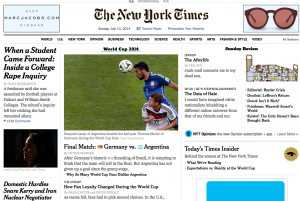By Suju Rajan
Replay the day of the World Cup final. Were you a super-fan engaging in the collective sounds of despair and hope, egging on your favorite team? Or were you “Neymar or nothing” when Neymar got injured, becoming indifferent to the outcome? Maybe you were “show me the scores” and just wanted to know the end-result… or perhaps even that didn’t matter. If you placed yourself in any of the above categories, where did you go for your World Cup news fix? With so many options, was it difficult for you to make a decision?
Traditional news sites attempt to cater to their specific audiences. For instance, the two portals SF Gate and San Jose Mercury News in the San Francisco Bay Area focused more on local events of that day while paying a nod to the World Cup.

 Portals with a larger demographic such as The New York Times placed more importance on the tournament.
Portals with a larger demographic such as The New York Times placed more importance on the tournament.
 Over the years such sites have learned what attracts their target demographic and perhaps even to optimize for it.
Knowing how best to cater to a specific target demographic is a well-defined problem. Personalizing for a global audience so each and every user has a stellar experience, like we do at Yahoo, is much more difficult (and measuring user satisfaction and optimizing for it requires a separate blog post in itself). But why is this problem so hard? Wouldn’t atraditional recommendation system work in this context?
Recommendation systems work best in the space of items (e.g. movies on Netflix, products on Amazon, songs on Pandora, etc.) that have a long shelf life. These items accumulate enough feedback over time to continue to be valid recommendation candidates in the future. News articles, on the other hand, have a much shorter shelf life, which makes it necessary for them to be recommended in a timely fashion. Typical solutions recommend news articles that are similar to ones you have already read. However, such “nearest-neighbors solutions” are obviously not optimal.
At Yahoo Labs, we want to answer why you read an article and in what context, so that when you go anywhere on the Yahoo site, we will know to how to show you what you are most interested in seeing. And to make your Yahoo experience more robust and delightful, our system doesn’t just recommend news articles, but also mobile apps, videos, and blogs.
So how does such a system work? To begin, we attempt to understand — or at least form a hypothesis on — why you read a given article in the first place. Then we continually test and refine that hypothesis. This user-understanding component needs not only to nail the space in which to represent all the interests of the users, but also to figure out the temporal aspects: Is your fascination with Argentina’s Lionel Messi a short-term or a long-term interest? Do you want to know if Messi sneezes or you are oblivious to his existence until the next World Cup in 2018?
Besides modeling user interests, this complex personalization system needs to rank the right articles in the right context. What do you prefer when you use your mobile phone to scan news: text or video? What do you like to read in the morning: local news or celebrity gossip? Do you prefer reading local news on a specific app? How do your preferences vary between your tablet or desktop? How can we also account for your news feed scroll behavior on your tablet as opposed to a desktop?
The Personalization Science team at Yahoo Labs is working hard to answer all of these questions and many more in order to provide our users with the best possible online experience. If the problem of identifying subsets of users who want to know about Messi’s sneezing (or not!) piques your interest, then stay tuned for more as we continue to explain the science behind personalizing Yahoo.
Over the years such sites have learned what attracts their target demographic and perhaps even to optimize for it.
Knowing how best to cater to a specific target demographic is a well-defined problem. Personalizing for a global audience so each and every user has a stellar experience, like we do at Yahoo, is much more difficult (and measuring user satisfaction and optimizing for it requires a separate blog post in itself). But why is this problem so hard? Wouldn’t atraditional recommendation system work in this context?
Recommendation systems work best in the space of items (e.g. movies on Netflix, products on Amazon, songs on Pandora, etc.) that have a long shelf life. These items accumulate enough feedback over time to continue to be valid recommendation candidates in the future. News articles, on the other hand, have a much shorter shelf life, which makes it necessary for them to be recommended in a timely fashion. Typical solutions recommend news articles that are similar to ones you have already read. However, such “nearest-neighbors solutions” are obviously not optimal.
At Yahoo Labs, we want to answer why you read an article and in what context, so that when you go anywhere on the Yahoo site, we will know to how to show you what you are most interested in seeing. And to make your Yahoo experience more robust and delightful, our system doesn’t just recommend news articles, but also mobile apps, videos, and blogs.
So how does such a system work? To begin, we attempt to understand — or at least form a hypothesis on — why you read a given article in the first place. Then we continually test and refine that hypothesis. This user-understanding component needs not only to nail the space in which to represent all the interests of the users, but also to figure out the temporal aspects: Is your fascination with Argentina’s Lionel Messi a short-term or a long-term interest? Do you want to know if Messi sneezes or you are oblivious to his existence until the next World Cup in 2018?
Besides modeling user interests, this complex personalization system needs to rank the right articles in the right context. What do you prefer when you use your mobile phone to scan news: text or video? What do you like to read in the morning: local news or celebrity gossip? Do you prefer reading local news on a specific app? How do your preferences vary between your tablet or desktop? How can we also account for your news feed scroll behavior on your tablet as opposed to a desktop?
The Personalization Science team at Yahoo Labs is working hard to answer all of these questions and many more in order to provide our users with the best possible online experience. If the problem of identifying subsets of users who want to know about Messi’s sneezing (or not!) piques your interest, then stay tuned for more as we continue to explain the science behind personalizing Yahoo.